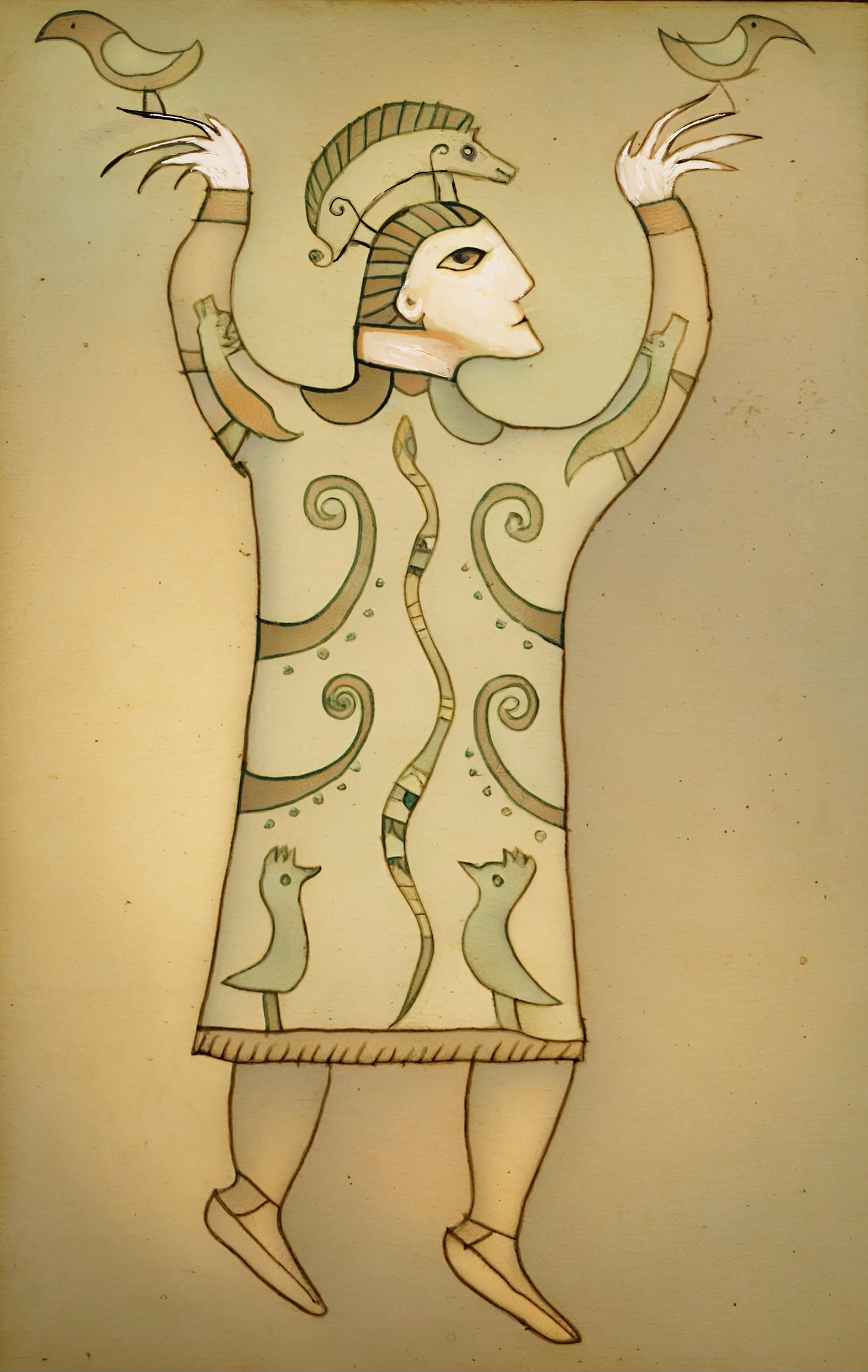Living in the West we tend to imagine the soul as a singular entity. This is largely due to centuries of Christian doctrine. However, as we shall see, ancient pagan ideas on the nature of the soul were more complex.
The Norse write of the hugr – a concept that indicates not only a soul-essence of an individual, but their thoughts, will and desires. Being a free-soul, it could wander beyond the confines of the body. This doesn’t mean that it was a wilful projection: it could be beyond the control of its host. By those with ‘the second sight’, the hugr of another could be detected as an aura about its owner.
The hugr had a supernatural companion, the fylgja* (the plural is fylgjur), often taking the form of boars, wolves, birds or bears. The name also translates as ‘fetch’. They were more than outward projections, and to some degree fylgjur reflected the moral qualities of an individual. Appearing in animal form they could help their host. They were believed to be tangible, literal and real. They lived their own lives and could be passed through generations of a family, enforcing their independence by rejecting those they deemed unworthy. Likewise, they could initiate a new host via a process of spiritual dismemberment, ensuring, by their adoption, a link with the transcendental realm of the Otherworld. Though a fetch might assume animal form, it could keep some recognisable attributes. I think it’s poignant to note that they were always female, even those belonging to men. They were often linked with prophecy, warnings and second sight. A powerful sorcerer could possess several fylgjur.
Skipta homum, or shape-shifting**, was a practise known amongst the ancient Scandinavians and tribes of Germania. The craft was confined to a few, although some were born with the skill***. Those gifted thus were known as hamrammr (shape-strong) and to fara i hamförum, or hamfarir, was to embark on a hamr-journey. The process involved a fundamental alteration of the shell of the hugr, known as the hamr. You can imagine this like a spiritual exoskeleton, intrinsically attached to the person. If a hamr were slain, so too the host would perish.
Another of the soul’s manifestations was known as the hamingja. This was a spiritual embodiment of good fortune and luck. However, rather than a shade of an individual’s soul, a hamingja was the spiritual guardian to a family or lineage. Its presence could continue through a family line, but it could also desert its hosts, or reappear. A hamingja could also be loaned to another person, even if they were not related. Hamingjur were often female and sometimes resemble descriptions of valkyries.
It’s thought by some that the fylgjur is the Hamr in animal form, but the concepts do meld into each other at times. This point is also made in relation to the hamingjur and fylgjur. And to confuse issues even further, the portrayal of the female spirits known as the dísir, are sometimes indistinguishable from those of the fylgjur. As with the distinction between animal and human, the Norse souls’ multiplicity was fluid.
Despite these overlaps, one thing is clear: the Norse perceived that there was a multiple soul, and that elements of this soul could be controlled (usually while dreaming or in trance-state), while other parts displayed a certain amount of autonomy.
Researcher, Dr. Stephen Flowers, isolates nine elements of soul, which he claims are traceable in Old Norse. He suggests that these comprised of the physical body (lík), the semi-physical body shape (hamr), inspiration (ódhr), vital breath (önd), a cognitive faculty (hugr), a reflective faculty (minni), a shade (sál/skuggi), a permanent magical soul (fylgja) and the essence that provided luck, protection and the shapeshifting ability (hamingja).
The idea that the soul consisted of multiple, independent components was not restricted to Northern Europe. Plato writes of multiple soul-elements, and similar ideas are traceable in Homer’s works. Amongst these concepts are the idea of the free-soul or psyche, and those concerned with the inner life of an individual: thymos, noos and menos. The Egyptian multiple soul included the Ka, or ‘life force’, the personality (Ba) and the immortal essence of a being, its akh. In Hinduism we find ideas such as the subtle body, causal bodies and the eternal soul embodiment of atman.
There’s something subtle and profound about these ancient concepts. The hugr, hamr and fylgja offer modes of self-realisation and transcendence that are neither unobtainable or remote. They suggest a shared experience, unrestricted to a single culture. These days such beliefs might fall within the umbrella of shamanism, and like shape-shifting, these ideas are as relevant today as they were in the past.
Notes:
*It means ‘follower’.
** Also known as hamhleypa. Shapeshifters could be eigi einhamr, ie: not of one shape.
*** The seidr, for example – deserving a future article to themselves. Odin too displays this skill, changing form into animals, fish or serpents.
References:
The Viking Way – Neil Price
Leechdom – Stephen Pollington
The Maiden With the Mead – Maria Kvilhaug
Iron Age Myth & Materiality – Lotte Hedeager
The Galdabok – Edred Thorsson (aka: Dr. Stephen Flowers)
The Road to Hel – Hilda Roderick Ellis







I followed the link to this post from your most recent. I don't often speak this openly on digital media, but the breath caught in my throat when I was reading this piece. A person having perhaps multiple animals associated with their 'soul', a 'female' dísir. I don't ascribe to the old ways but I believe there is truth in what you say. I'm a Christian (of fundamental beliefs without the blasphemies of the Church) but there is truth to the unfiltered observations of our ancient kin.